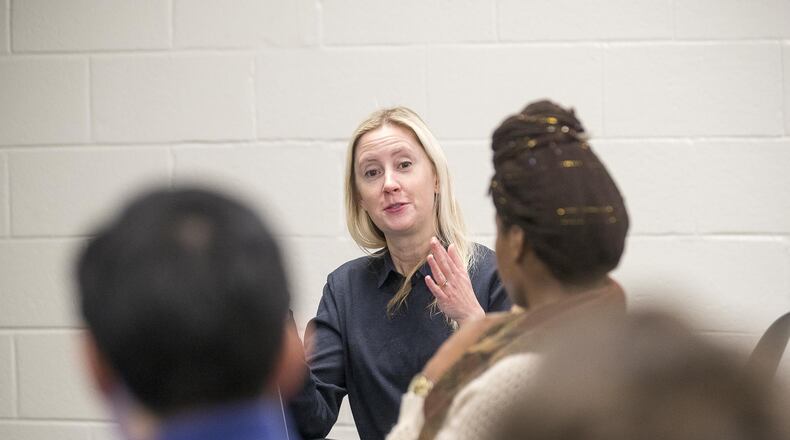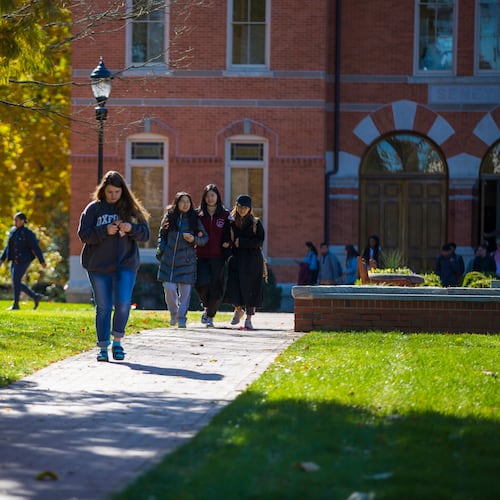Kennesaw State University professor Mary "Meg" Murray knew the risks when she sued her employers a decade ago.
She believed she was a victim of gender discrimination after discovering a male faculty member with a similar work history had a higher salary.
Murray thought she had done everything she was supposed to do to earn a fair salary: She published extensive research, coordinated faculty programs, chaired committees and received top marks on evaluations.
The discovery stung.
“I felt used,” Murray, an information systems professor, said in a recent interview.
Murray knew the lawsuit could stall her career prospects, but she believed it was important to raise awareness to what she saw as a longstanding problem: male professors being paid more than women.
“I hoped it would bring a little attention to the pay gap,” said Murray. “I don’t think I achieved that, but I tried.”
A decade after filing her lawsuit, pay gaps still persist between men and women on some of the country’s largest campuses, including some in Georgia.
Kennesaw State, for example, pays male full professors an average salary of $94,173 and women $87,202, an 8 percent difference, according to an internal study completed for the university last November. A 2015 Georgia Tech study found the average salary for male full professors was $145,011 in comparison to $126,366 for women, a 15 percent difference. Nationally, the gap is between 10 and 18 percent, according to some research.
Acknowledging the problem
The gender pay gap has made it difficult for some Georgia schools to hire or keep female professors because the women feel underpaid. With more women entering Georgia colleges' teaching ranks, the pay deficit is critical. Since 2007, the percentage of female faculty members in the University System of Georgia has increased from 43 percent to more than 46 percent, according to system data. There are nearly 12,000 faculty members in the system.
READ | Report: Women must get one more degree to have same earnings
Jackie Yalta, a second-year University of Georgia student, said she’s found female professors easier to talk to, echoing national research that most students connect and perform better in classes with educators who look like them.
“Why should they get paid less due to gender?” asked Yalta, 19, who’s from Gwinnett County and is studying biology and psychology. “It’s eye-opening and shameful.”
University System officials say they’ve tried to close the gap through professional development programs, recruiting more women in science, technology, engineering and math (STEM) fields and providing more leadership opportunities for women.
“While some schools found virtually no difference between male and female salaries, others identified areas for improvement and began addressing them,” the system said in a statement.
The Atlanta Journal-Constitution reviewed state salary reports from a Georgia Department of Audits and Accounts database for the last school year for approximately 3,000 full, research and Regents professors in the entire University System and found male professors make an average salary about 23 percent more than women. The greatest gaps were among faculty teaching STEM, subjects where women have been historically underrepresented.
University System officials noted the state data doesn’t distinguish between how faculty are paid; some over 12 months, some over nine months. The internal KSU study tried to account for such differences by adjusting 12-month salaries to nine-month equivalents, said its author, University of Georgia professor Robert Toutkoushian.
System officials and researchers say the gaps aren’t as great when comparing men and women who teach similar subjects for a similar amount of time. They pointed to an internal University of Georgia study of 2014-15 salaries that found the gap, after accounting for such factors, is less than 2 percent.
READ | Georgia ranks among worst states in America in women's equality (again)
Still, no one disputes pay gaps exist. In its annual report on professor salaries, the American Association of University Professors found men made more than women on all professorial ranks during the 2017-18 school year. The pay gap has changed little for full professors during the past decade, its research shows.
“(T)he available data clearly show that more work is needed to end the pay gap in higher education,” the report said.
‘A national economic issue’
Reasons for the disparity vary. One frequent explanation is many male professors have been teaching longer. Another rationale is men more frequently teach classes in lucrative professions. Female faculty members often get less mentoring than men, so many don’t know what’s necessary to become tenured, some women say. Several female faculty interviewed also said men are typically more persistent in negotiating higher salaries for themselves.
Toutkoushian said such research is important because of continued concerns that females may not always be compensated fairly.
“This can occur in all sorts of organizations, including colleges and universities,” he said.
Citigroup released a report earlier this month that its female employees made 29 percent less than its male employees globally. An Emory University graduate student co-authored a study released this month that found male congressional staffers made about 17 percent more than women between 2010-2014.
Jessica Milli, study director at the Institute for Women’s Policy Research, said research shows if American women were paid on par with men, poverty would be reduced in half and the nation’s economy would improve.
“This isn’t a women’s issue,” Milli said. “It’s a family issue. It’s a national economic issue.”
However, few female faculty members in Georgia have publicly addressed the pay disparity. Murray, the KSU professor, recalled a few women privately thanked her when she sued. Many women are afraid to complain, fearing backlash from administrators, she said.
Ultimately, Murray lost her case. The judge noted the male professor's pay was higher because KSU matched a competing salary offer from another school when he was hired.
Murray believes the pay gap will close when schools conduct more frequent research on the topic and work harder to end bias. Some male researchers, she said, are reluctant to work with women, fearing their research won’t be taken seriously. She’s noticed some men address male faculty as “Doctor” and women with a similar degree as “Miss.”
“There’s still a belief that the male is the expert and that recognition comes in salaries,” she said.
Active steps toward balance
Erika James, dean of Emory University’s Goizueta Business School, said one of her unwritten responsibilities is to help female professors grappling with such issues.
James said when she took the Emory job in 2014, she asked to see the compensation and titles of all faculty members. She looked at who got raises, how much they received and when they took place. One finding: Finance faculty members were paid more than those teaching in other areas. More men receive degrees in finance, she said.
James looked for more female doctoral degree candidates at other colleges and universities, particularly at schools Emory typically didn’t consider, who could someday teach there. Each year, the school hosts a conference specifically for female MBAs and perspective MBA students. Forty-five percent of Goizueta’s faculty hires since 2014 have been women, the university said.
“I have to walk the talk as much as anyone else,” James said in an interview.
Kimberly Kurtis, an administrator and engineering professor at Georgia Tech, said the pay gap there is largely a result of fewer women studying courses taught there.
“I think it’s a pipeline issue,” she said during a recent interview in her office on campus. “It begins in middle school and even earlier to getting young women really excited about science and engineering. There’s so much more we need to do.”
Georgia Tech does annual research to track hiring, endowed positions and gender breakdowns of faculty candidates interviewed, Kurtis said. In some cases, Georgia Tech has boosted pay for some faculty members who may be underpaid.
Georgia Tech has tried to boost the numbers of female students through summer programs, career fairs and other methods. Some progress is being made, Kurtis said. Someday, perhaps, some of those women will become faculty, they hope.
Georgia Tech has more female faculty members than any engineering college or university in the nation, she said. Still, more than 75 percent of Tech’s faculty are men, according to an annual report by the University System.
“We’re definitely conscious that this is something we need to keep an eye on,” Kurtis said. “I think we’re doing a reasonably good job. I think there are some issues we need to address. We’re not perfect but it’s something we definitely try to stay on top of.”
Kurtis said she had to end the interview shortly afterward. She received a previously scheduled call from someone to discuss teaching at Georgia Tech.
The job candidate, Kurtis said, is a woman.
BY THE NUMBERS
Here’s a breakdown of average male and female professors’ salaries from recent studies:
Kennesaw State University 2018
Male Professor $94,173
Female Professor $87,202
Male Associate Professor $75,293
Female Associate Professor $70,980
Male Assistant Professor $68,177
Female Assistant Professor $67,213
Georgia Tech 2015
Male Professor $145,011
Female Professor $126,366
Male Associate Professor $103,030
Female Associate Professor $101,079
Male Assistant Professor $95,950
Female Assisstant Professor $94,500
HOW WE GOT THE STORY
The Atlanta Journal-Constitution downloaded salary data for the most recent fiscal year for University System of Georgia employees from the Georgia Department of Audits and Accounts. The AJC broke down the data for full, research and Regents professors — approximately 3,000 employees — and calculated average salaries for men and women.
The data does not detail how many years each professor has been teaching or what subject each faculty member teaches. The AJC also reviewed past salary surveys by Georgia Tech, Kennesaw State University, the University of Georgia and the American Association of University Professors.
About the Author
Keep Reading
The Latest
Featured

![Women have made great strides in many fields that previously — and to some degree still — were considered the domain of men, such as law and medicine. But in science, technology, engineering, and mathematics, the STEM fields, women remain vastly underrepresented. The reasons are many, including culture, gender bias, and stereotyping. Even so, some […]](https://www.ajc.com/resizer/v2/CZ6RRDFNNRBWNENEKR4XU33OVI.jpg?auth=c8760d82dc358791d32b84dc23e53fb668f7cec1746a482153f8730e10cededb&width=600&smart=true)




